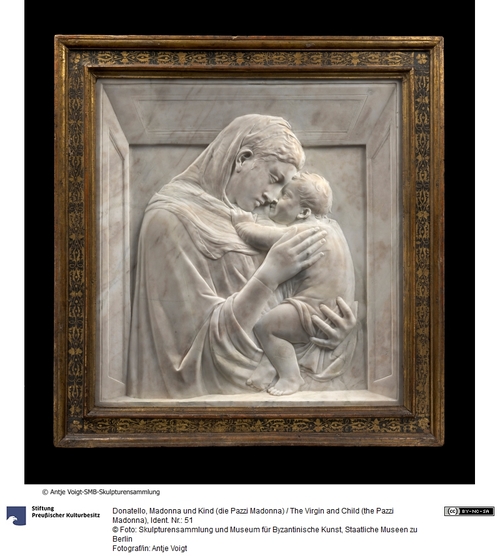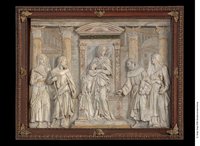The Pazzi Madonna, said to come from the palace of the Pazzi family in Florence, is one of the greatest masterpieces of Donatello and an emblem of early Renaissance sculpture. It embodies the aspiration of artists of the time at representing a convincing reality. The Virgin and Child are represented life-size and framed in a niche which follows the rules of linear perspective: the receding lines of the niche converge in one single point. As a result, both figures seem to emerge into the world of the spectator. The relationship of the mother with her child is another key aspect of the work: Mary is laying her forehead on Jesus’, in a gesture that can be read as both tender and violent. She is sad for one reason: she knows that her son will die too soon.
--
Donatello
Donato di Niccolò di Betto Bardi
Florence, ca. 1386-1466
Virgin and Child (called the Pazzi Madonna)
ca. 1420
Marble
91 x 87 x 10 cm
The frame is not original.
Berlin, Staatliche Museen, Skulpturensammlung, Inv. SKS 51.
Bode-Museum, on view.
Provenance
Florence, Pazzi Palace, courtyard (?); Florence, Raffaello Lamponi Leopardi (1886); Florence, Stefano Bardini (1886); Berlin, Skulpturensammlung/Altes Museum (1886-1904); Berlin, Skulpturensammlung/Kaiser-Friedrich-Museum (1904-39); Berlin, storage (1939-45); Merkers, storage (1945); Wiesbaden, Central Collecting Point (1945-56); West Berlin, Skulpturensammlung/Museum Dahlem (1956-97); Berlin, storage (1997-2006); Berlin, Skulpturensammlung/Bode-Museum (since 2006).
Acquisition
Bought from the dealer Stefano Bardini in 1886; the inventory book of the Bode-Museum mentions the price as 20,000 Mark.
The acquisition file of the Berlin Museum (1202/86) is missing from the Zentralarchiv der Staatlichen Museen zu Berlin.
The acquisition file is still preserved in the Bardini Archive, Florence: Polo Museale fiorentino, Archivio Stefano Bardini, CORR.I.B.1: bill of the 14 February 1886 (“1 Madonna di Casa Pazzi dal Donatello Lire 25.000”).
Restorations
1967; 1979; 2009.
Exhibitions
John Flaxman and the Renaissance. A Master of Neo-Classicism in Dialogue with Masaccio and Donatello, Berlin, Bode-Museum, 9 April-12 July 2009, cat. 10.
La primavera del Rinascimento. La scultura e le arti a Firenze 1400-1460, Florence, Palazzo Strozzi, 23 March-18 August 2013, cat. VIII. 5 / Le Printemps de la Renaissance. La sculpture et les arts à Florence 1400-1460, Paris, Musée du Louvre, 26 September 2013-6 January 2014, cat. VIII. 5.
Other versions
• Amsterdam, Rijksmuseum, Inv. NM 11935. Painted stucco, diameter: 70 cm, framed in the style of the Della Robbia.
• Bologna, Chiesa della Certosa. Stucco.
• Budapest, Szépmüvészeti Múzeum.
• Cambridge (Mass.), Fogg Art Museum.
• Castrocaro Terme, chiesa dei Santi Niccolò e Francesco.
• Dovadola, private collection. 71 x 52 x 4 cm.
• Florence, Conservatorio delle Signore Montalve alla Quiete.
• Florence, Convento della Calza.
• London, Victoria and Albert Museum, Inv. A.51-1935. Painted stucco, 50.8 x 37.5 cm.
• New York, The Metropolitan Mu
de

